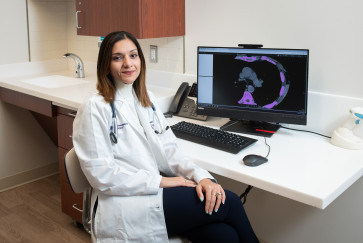Being near and having more exposure to urban green space and blue (water) space is linked to lower odds of having coronary artery calcification in middle age, which is an early marker of cardiovascular disease, according to a new Northwestern study.
The associations were more pronounced among Black individuals and those living in neighborhoods with lower socioeconomic status, with the strongest effects observed in Black individuals in economically deprived neighborhoods.
“The protective effect of having access to urban blue and green spaces with coronary artery calcification highlighted in our study underscore the potential benefits of such infrastructure, particularly for underserved populations at higher risk for cardiovascular disease,” said corresponding author Dr. Lifang Hou, a professor of preventive medicine at Northwestern University Feinberg School of Medicine. “Our findings provide quantitative evidence supporting environmental policies to enhance the accessibility and quality of residential blue and green spaces, which can benefit public health and address racial and neighborhood-related health disparities.”
What are green and blue spaces?
These are residential-surrounding natural environments. Examples of blue spaces are rivers or shoreline, while examples of green spaces include parks or forests.
What is coronary artery calcification (CAC)?
Coronary artery calcification (CAC) is when calcium builds up in the plaque found in the walls of the coronary arteries. It can be a sign of early coronary artery disease, which can cause a heart attack.
How was the study was conducted?
The study, published in Circulation on June 27, included 2,960 Black and white men and women (average age of 50 years) from Birmingham, Ala., Chicago, Ill., Minneapolis, Minn., and Oakland, Calif., who were followed for 25 years. Researchers examined the associations between each blue and green space and CAC by race and neighborhood socioeconomic status.
What were the results?
Black participants with the highest accessibility to a river had 32% lower odds of coronary artery calcification compared to those with the lowest accessibility. Black participants with greater access to green spaces had up to 35% lower odds of calcification. For each 10%-point increase in green space, the odds of having coronary artery calcification decreased by 15% on average.
Why do green and blue spaces improve health?
“Having more green and blue spaces may provide increased opportunities for physical activities, social interactions, stress relief and restoration, all of which have been linked to improved metabolic and cardiovascular health,” Hou said. “Additionally, exposure to green and blue spaces has been shown to boost people’s immune system, reduce chronic inflammation and slow down the biological aging process, all of which are biologically important in people’s overall health and cardiovascular health. More studies are needed to fully understand the role of urban natural environments in pathways related to human health.”
Do parks have the same benefit?
The study showed shorter distances to parks were actually associated with higher odds of CAC in these neighborhoods, with individuals having the highest park accessibility showing 29% higher odds of CAC compared to those with the lowest accessibility.
“The poor condition of parks and/or safety concerns in underserved urban neighborhoods might deter park use and prevent residents from fully benefiting from these spaces,” said study first author Kyeezu Kim, adjunct assistant professor of preventive medicine at Feinberg and assistant professor at Sungkyunkwan University School of Medicine in South Korea. “From a public health perspective, the results suggest the need for quality control and management of the surrounding environment in neighborhoods with disadvantaged social determinants of health. More data is warranted to fully explain this observation.”


